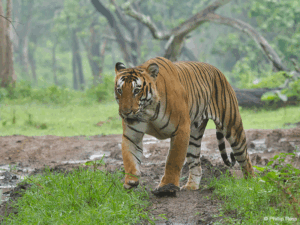Bor Wildlife Sanctuary Tiger
BOR TIGER RESERVE WILDLIFE SANCTUARY
Introduction
BOR TIGER RESERVE WILDLIFE SANCTUARY
Bor tiger reserve is located 40 km from Wardha district administration and 65 km from Nagpur.
where wild animals like tigers, foxes, dogs and bears are seen. Peacocks are abundant.
This place is worth a visit.
The central government has declared the Bor sanctuary in Wardha district of Vidarbha as
a ‘tiger project’ due to the increase in the number of
tigers in the area due to the abundance of natural resource.
It is the sixth tiger sanctuary after Tadoba, Melghat, Pench Nagzira and Sahyadri Sanctuaries and covers.
on an area of about 13 thousand 812 hectares and which is home to tigers as well as leopards and bears.
The habitat of the tigers has changed due to the dense forest and the abundance of
water,but also due to the many other animals that the tigers need to hunt.
This area, which is the only place in the country with a very small area, but with
the Central Government Forest Department has declared a high tiger population as a ‘Tiger Reserve’
Car Facilities for Bor Tiger Reserve Safari
BOR TIGER RESERVE WILDLIFE SANCTUARY
There is an irrigation project on the Bor River, which flows through the tiger reserve itself.
There is an tourist information center for tourists at the entrance of Bor Dam and
It is from here that permission is granted to visit the Bor Tiger Reserve.
Cars are also available for safari.
Four wheeler vehicle is allowed for forest visit and permission is given for passenger vehicle,
person and forest guards of the forest department on payment of due fee.
In this fee, if you are going from Monday to Friday, then you have to pay 4 thousand 375 rupees for six persons.
Along with this you get 1 guide. 6,000 is charged on weekends i.e. Saturdays and Sundays.
Tourists have been made easy to enjoy jungle tours every day from 6 AM to 11 AM and 2 PM to 6 PM.
How to reach bor tiger reserve ?

BOR TIGER RESERVE WILDLIFE SANCTUARY
BOR TIGER RESERVE WILDLIFE SANCTUARY
by plane:-
Nagpur is the nearest domestic airport connected to Mumbai, Pune and Nagpur
other Indian airports with regular international flights.
While reaching Nagpur by air, one can reach Wardha by rail or road as per their personal preference.
By rail:-
BOR TIGER RESERVE WILDLIFE SANCTUARY
Wardha is the nearest railway station to Bor Wildlife Sanctuary and
is directly connected to Mumbai, Pune, Nagpur and other cities.
Wardha is easily accessible by car and from Wardha tourists travel by road to Hingani and then take tourist cars and jeeps for the sanctuary.
Although Wardha is the nearest railway station at a distance of 32.5 km,
Buti Bori Railway Station (50.2 km) is another option used by tourists to reach Bor Sanctuary.
By car:-
BOR TIGER RESERVE WILDLIFE SANCTUARY
Regular buses are available for Bor Wildlife study from
cities like Mumbai, Pune, Nagpur, Akola, Amravati and Wardha.
Hingi (Hingani) is the nearest receipt from the sanctuary at a distance of 5 km.
Wardha can be easily reached from Mumbai, Pune and
Nagpur through state transport company buses and
various Hingini from Wardha can be reached through local buses.
From Hingani bus, tourist car seats and jeeps can be allocated directly to the visitors who will be tourists.
Bor Tiger Reserve Wildlife Sanctuary: An Overview
The Bor Tiger Reserve, located in the Nagpur district of Maharashtra, India, is a haven for wildlife enthusiasts and nature lovers alike. Nestled at the convergence of the Godavari and Wardha rivers, this sanctuary is a picturesque blend of rich biodiversity, dense forests, and unique terrain. Covering an area of 1,520 square kilometers, Bor Tiger Reserve is one of the lesser-known gems in Maharashtra’s rich wildlife heritage. It was established in 1970 as a sanctuary and later designated as a Tiger Reserve in 2014 under the Project Tiger initiative. The reserve derives its name from the Bor River, which flows through the sanctuary, adding to its natural charm.
Geographical Location and Climate
BOR TIGER RESERVE WILDLIFE SANCTUARY
Bor Tiger Reserve is situated in the central part of Maharashtra, near the borders of Madhya Pradesh, in the Vidarbha region. The nearest town to the reserve is Hinganghat, and it is approximately 50 kilometers from Nagpur. The region enjoys a tropical climate, with hot summers, a monsoon season, and mild winters. Summers (from March to June) can be extremely hot, with temperatures soaring above 40°C, while the monsoon season brings relief with heavy rains, making the flora lush and vibrant. Winters, from November to February, are relatively pleasant, with temperatures ranging between 10°C to 25°C.
Flora and Fauna
BOR TIGER RESERVE WILDLIFE SANCTUARY
The Bor Tiger Reserve is blessed with a diverse range of flora and fauna. The landscape consists of mixed deciduous forests with a wide variety of trees such as teak, bamboo, tendu, and sal. The dense forest cover is interspersed with grasslands, waterholes, and open clearings, creating an ideal habitat for various species of wildlife. This rich ecosystem is home to numerous plant species, providing food and shelter to a vast array of animals, including endangered and vulnerable species.
Fauna
The main attraction of Bor Tiger Reserve is, of course, the Bengal Tiger (Panthera tigris tigris). The reserve plays a significant role in the conservation of tigers in Maharashtra, especially as part of the Project Tiger initiative. As a critical tiger habitat, the reserve has been successful in sustaining a healthy population of tigers. The Bor Tiger Reserve also harbors other important carnivores such as leopards, wild dogs (dhole), jackals, and hyenas.
Apart from tigers, the sanctuary is home to a wide range of other animals, making it an important biodiversity hotspot. Some of the other key mammal species found here include:
- Indian Bison (Gaur): This large herbivore is one of the most striking animals found in the sanctuary.
- Sambar Deer: A significant prey species for tigers, these large deer are commonly seen in the reserve.
- Chital (Spotted Deer): Another common herbivore, known for its elegant appearance.
- Nilgai (Blue Bull): These are large antelopes often seen grazing in the open areas of the reserve.
- Wild Boar: A common sight, these boars are an essential part of the food chain in the ecosystem.
- Sloth Bears: Found in the denser parts of the reserve, they are mainly nocturnal and often forage for fruits, insects, and small animals.
In addition to mammals, Bor Tiger Reserve is home to a rich variety of avian species, making it a birdwatcher’s paradise. The reserve is an important habitat for both migratory and resident birds. Some of the notable bird species include:
- Indian Peafowl (Peacock): The national bird of India, known for its majestic appearance.
- Rufous-tailed Shrike
- Crested Serpent Eagle
- Indian Vulture
- White-eyed Buzzard
The reserve also has a significant population of reptiles, amphibians, and insects, contributing to its ecological richness. The presence of water bodies attracts numerous amphibians like frogs and turtles.
Conservation Efforts
BOR TIGER RESERVE WILDLIFE SANCTUARY
Bor Tiger Reserve is an important part of the broader conservation efforts to protect the Bengal tiger population in India. Since its inclusion under the Project Tiger initiative, the reserve has witnessed significant strides in the conservation of tigers and other wildlife species. The management practices include regular monitoring, anti-poaching patrols, and habitat management, aimed at maintaining the ecological balance within the sanctuary.
The Maharashtra Forest Department, along with various wildlife organizations, has worked tirelessly to protect the flora and fauna of the reserve. The reserve also provides a safe habitat for species like the Indian bison and the wild boar, whose populations have been declining elsewhere due to habitat loss and poaching.
Efforts are also being made to minimize human-wildlife conflicts, a common issue in areas surrounding the reserve. Measures include creating awareness among local communities, relocating villages from the core areas of the sanctuary, and implementing conservation-friendly policies.
Tourism and Activities
BOR TIGER RESERVE WILDLIFE SANCTUARY
Bor Tiger Reserve is a growing destination for wildlife tourism, especially for those interested in observing tigers in their natural habitat. The sanctuary offers a range of activities for tourists, including:
- Safari Rides: The most popular activity in the reserve, offering visitors a chance to see tigers, leopards, and other wildlife up close. Both jeep and canter safaris are available.
- Bird Watching: The sanctuary is a birdwatcher’s paradise, with many species of resident and migratory birds.
- Nature Walks: Guided nature walks are offered, allowing visitors to explore the flora and fauna of the reserve in greater detail.
- Photography: With its stunning landscapes and diverse wildlife, the reserve is an excellent spot for wildlife photography.
Conclusion
Bor Tiger Reserve Wildlife Sanctuary is an essential part of Maharashtra’s natural heritage and a critical site for the conservation of tigers and other wildlife species. Its diverse ecosystem, along with significant conservation efforts, has made it a successful example of wildlife protection. For nature lovers and wildlife enthusiasts, Bor Tiger Reserve offers an enriching experience, with its lush forests, abundant wildlife, and a peaceful, pristine environment. It stands as a testament to India’s commitment to preserving its wildlife and promoting ecological balance.

Bor Wildlife Sanctuary Tiger
READ MORE:-Manas Tiger Reserve: Exploring the Pride of Assam



